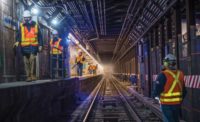
Digging tunnels, design-build delivery and diversity—Louis P. Brais, project executive for Bouygues Construction, is drawn to all three. And his expertise in these areas proved crucial to the successful construction of what many thought was impossible: excavating through eight different layers of geology to build the $1-billion Port of Miami Tunnel on time and budget.
 |
| BRAIS |
The project to build a pair of 4,200-ft-long highway tunnels under Biscayne Bay will take trucks off local streets and directly to and from the Port of Miami. It features the first-ever American use of availability payments for a public-private partnership and marks Bouygues' first venture into the U.S.—with a lot of other firsts as well.
"This project was the first public-private partnership advertised in the state of Florida and its first bored tunnel, so we were a little nervous about being able to deliver it on time after hearing about problems on other tunnel projects," says Mark Croft, Florida Dept. of Transportation District 6 construction engineer. "But finishing this project late was never an option for Louis, and he has pushed his team to deliver the project on time, frequently proceeding at risk to stay on schedule and working through changes and the geotechnical challenges of mining in Miami's mixed-face conditions."
Those mixed-face conditions include eight different layers of earth, including a coralline limestone that practically melts when wet. Using both the earth-pressure-balance method (EPBM) and water-controlled pressure, or hydraulic mucking, the team managed to excavate through that treacherous layer for the first time. Floridians "were surprised that anyone would even try," notes Brais.
Brais' communication skills came in handy as he reached out to skeptics in the Miami community. Locals also were worried about construction in and around the bay and doubted the new route really wouldn't be tolled, recalls Brais. He met with them, "and now they are our friends," he adds.
Both bluntness and eloquence mark Brais' management style, adds Croft. "Louis is very knowledgeable about tunnel construction and direct in his communication, almost to a fault. His directness sometimes ruffled feathers, but we always knew where he stood on the issues—and it is always better to get them out on the table so that you can resolve them faster."
Bouygues, as the lead contractor for the concessionaire Miami Access Tunnel, also reached out to the diverse Miami labor force. "We have awarded nearly $300 million in contracts to local businesses, 83% of our 500 direct employees are local hires, and—at Louis' insistence that this project leaves a positive impact—nearly $1 million will have been donated to area non-profits by the time we are done," says Luz Weinberg, a spokeswoman for Bouygues.
Brais started his career with heavy-civil experience in Montreal, then moved to Boston and eventually got bit by the overseas bug, he says. Building pipelines and tunnels in far-flung locations such as North Africa and Jamaica, he began to garner experience with alternatives to design-bid-build. "For large, complex projects, you can bring to bear all the experience you have to improve the design," he says of design-build. "And you can react quickly" to unexpected issues.
Such traits were crucial as Brais guided the team in the innovative use of concrete soil mixing and the redesign of the twin tunnel portals into single portals containing two bores. The team also custom-built a rotating Teflon plate that U-turned the tunnel-boring machine Harriet's cutterhead to begin the second 42.3-ft-dia bore. As the project nears completion, says Brais, "every day I have a vision of how the truck traffic will roll right past downtown."



Post a comment to this article
Report Abusive Comment